Robotics and Virtual Reality in Healthcare: Challenges and Benefits
VerifiedAdded on 2022/12/21
|12
|728
|23
Report
AI Summary
This report examines the applications of robotics and virtual reality (VR) in healthcare management. It explores the managerial responsibilities associated with these technologies, highlighting how robotics can improve efficiency by automating tasks and potentially reducing nurses' workloads, thus enhancing the quality of care. The report also discusses how VR can improve patient outcomes by providing pain management solutions and facilitating communication. Furthermore, it addresses the obstacles healthcare providers face when adopting these technologies, such as high costs, the need for specific infrastructure, and potential impacts on human jobs. References to Forbes and HADAC articles support the analysis, offering insights into real-world applications and challenges in the evolving landscape of healthcare technology.
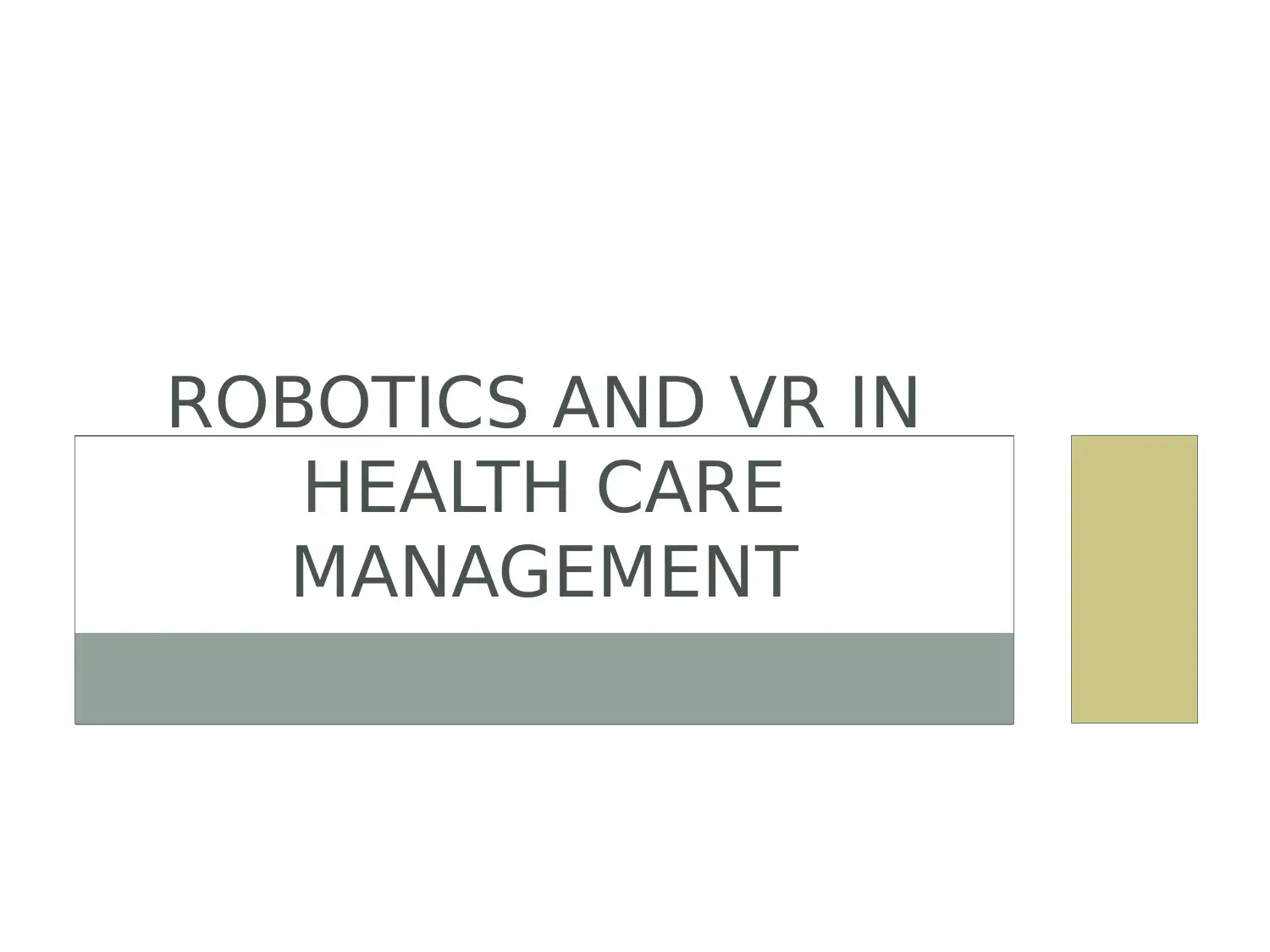
ROBOTICS AND VR IN
HEALTH CARE
MANAGEMENT
HEALTH CARE
MANAGEMENT
Paraphrase This Document
Need a fresh take? Get an instant paraphrase of this document with our AI Paraphraser
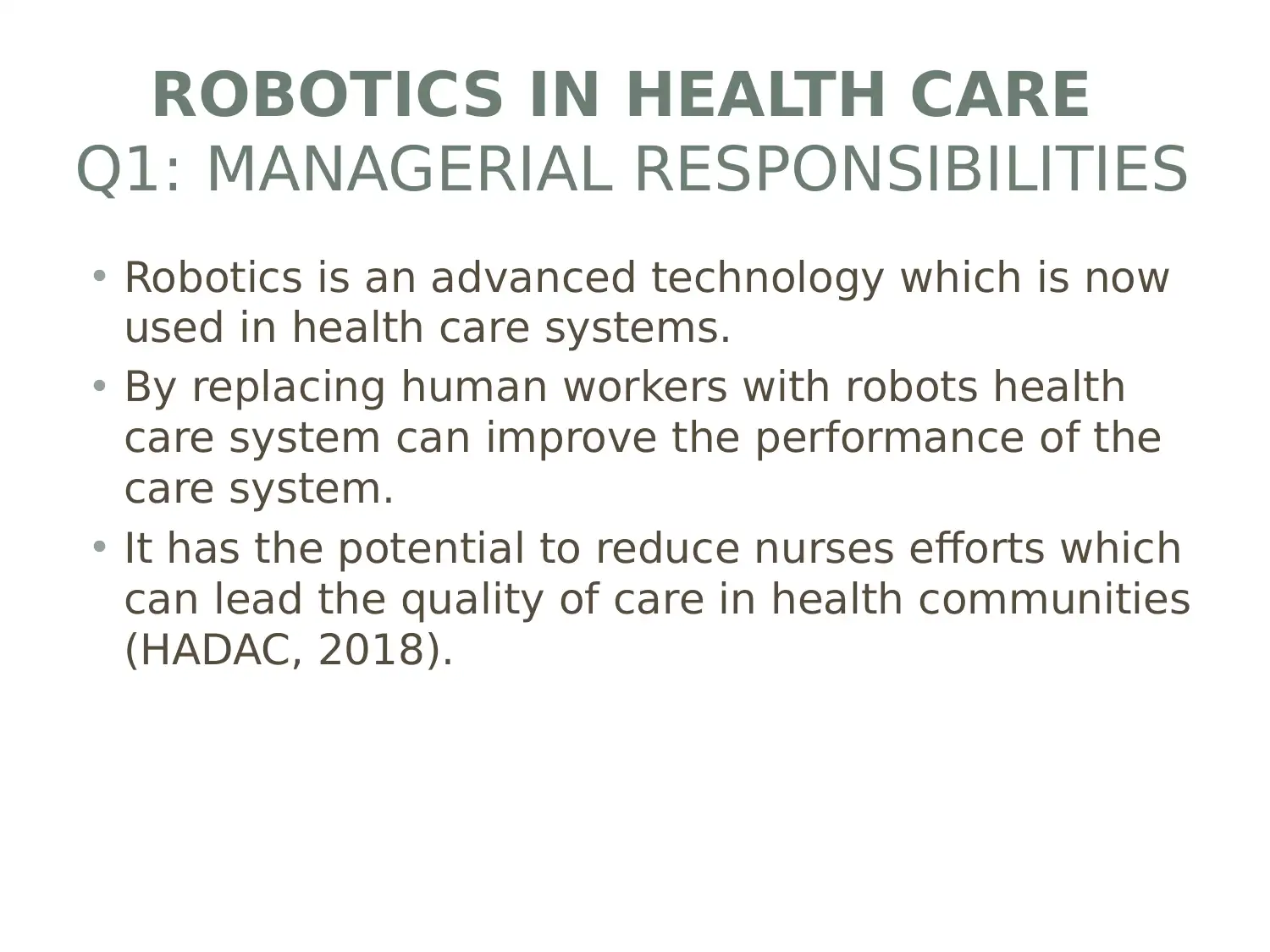
ROBOTICS IN HEALTH CARE
Q1: MANAGERIAL RESPONSIBILITIES
• Robotics is an advanced technology which is now
used in health care systems.
• By replacing human workers with robots health
care system can improve the performance of the
care system.
• It has the potential to reduce nurses efforts which
can lead the quality of care in health communities
(HADAC, 2018).
Q1: MANAGERIAL RESPONSIBILITIES
• Robotics is an advanced technology which is now
used in health care systems.
• By replacing human workers with robots health
care system can improve the performance of the
care system.
• It has the potential to reduce nurses efforts which
can lead the quality of care in health communities
(HADAC, 2018).
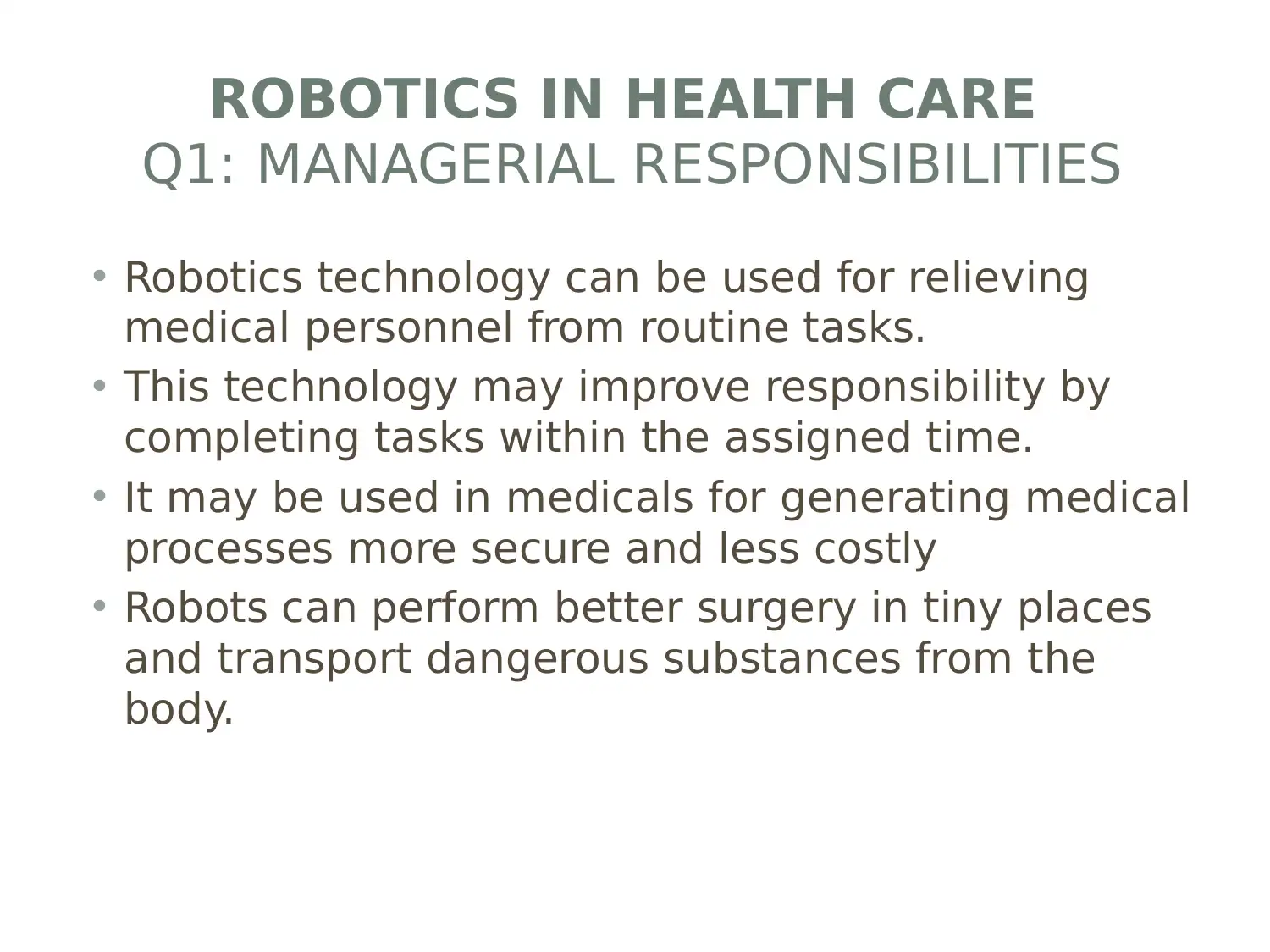
ROBOTICS IN HEALTH CARE
Q1: MANAGERIAL RESPONSIBILITIES
• Robotics technology can be used for relieving
medical personnel from routine tasks.
• This technology may improve responsibility by
completing tasks within the assigned time.
• It may be used in medicals for generating medical
processes more secure and less costly
• Robots can perform better surgery in tiny places
and transport dangerous substances from the
body.
Q1: MANAGERIAL RESPONSIBILITIES
• Robotics technology can be used for relieving
medical personnel from routine tasks.
• This technology may improve responsibility by
completing tasks within the assigned time.
• It may be used in medicals for generating medical
processes more secure and less costly
• Robots can perform better surgery in tiny places
and transport dangerous substances from the
body.
⊘ This is a preview!⊘
Do you want full access?
Subscribe today to unlock all pages.

Trusted by 1+ million students worldwide
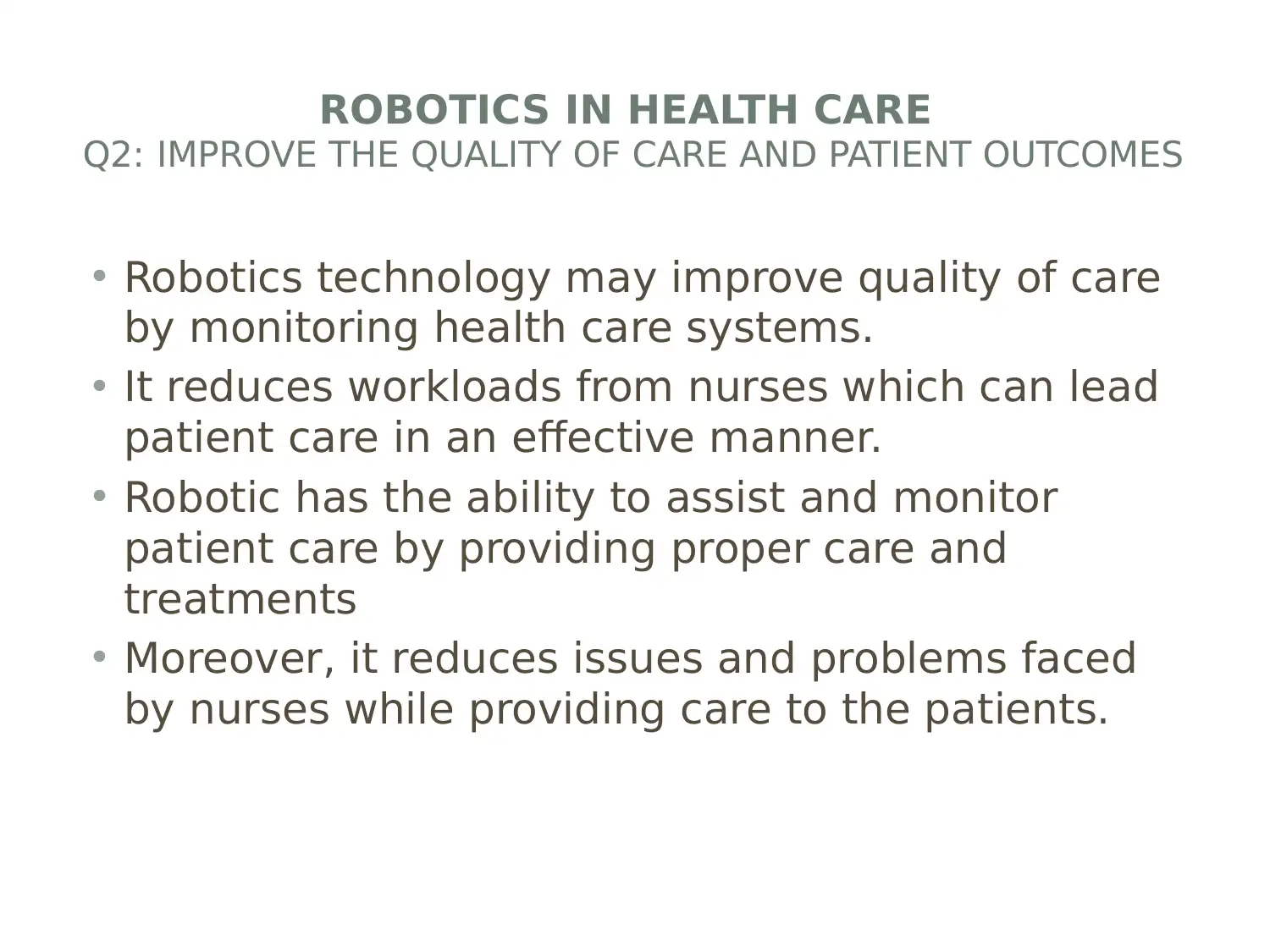
ROBOTICS IN HEALTH CARE
Q2: IMPROVE THE QUALITY OF CARE AND PATIENT OUTCOMES
• Robotics technology may improve quality of care
by monitoring health care systems.
• It reduces workloads from nurses which can lead
patient care in an effective manner.
• Robotic has the ability to assist and monitor
patient care by providing proper care and
treatments
• Moreover, it reduces issues and problems faced
by nurses while providing care to the patients.
Q2: IMPROVE THE QUALITY OF CARE AND PATIENT OUTCOMES
• Robotics technology may improve quality of care
by monitoring health care systems.
• It reduces workloads from nurses which can lead
patient care in an effective manner.
• Robotic has the ability to assist and monitor
patient care by providing proper care and
treatments
• Moreover, it reduces issues and problems faced
by nurses while providing care to the patients.
Paraphrase This Document
Need a fresh take? Get an instant paraphrase of this document with our AI Paraphraser
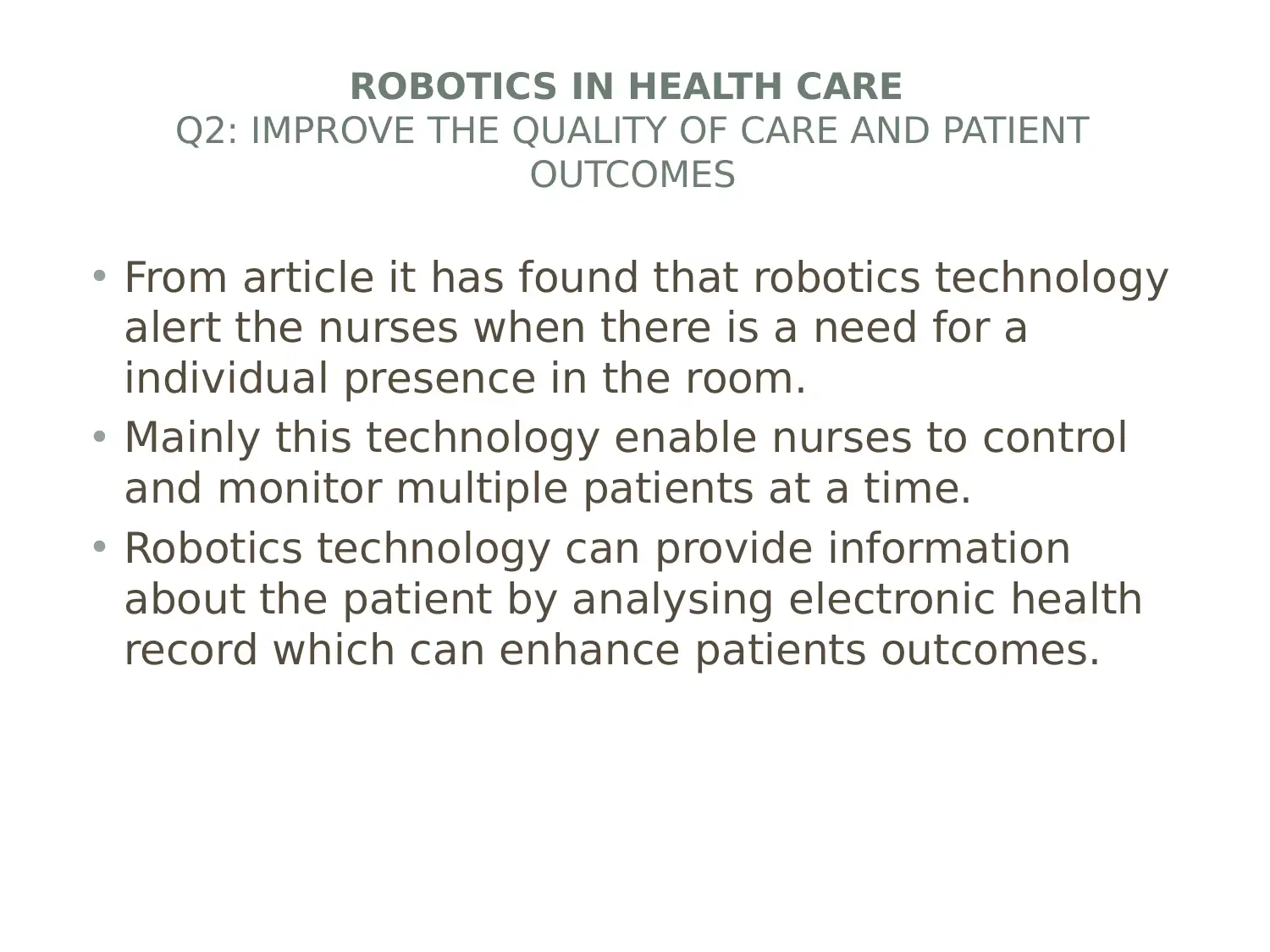
ROBOTICS IN HEALTH CARE
Q2: IMPROVE THE QUALITY OF CARE AND PATIENT
OUTCOMES
• From article it has found that robotics technology
alert the nurses when there is a need for a
individual presence in the room.
• Mainly this technology enable nurses to control
and monitor multiple patients at a time.
• Robotics technology can provide information
about the patient by analysing electronic health
record which can enhance patients outcomes.
Q2: IMPROVE THE QUALITY OF CARE AND PATIENT
OUTCOMES
• From article it has found that robotics technology
alert the nurses when there is a need for a
individual presence in the room.
• Mainly this technology enable nurses to control
and monitor multiple patients at a time.
• Robotics technology can provide information
about the patient by analysing electronic health
record which can enhance patients outcomes.
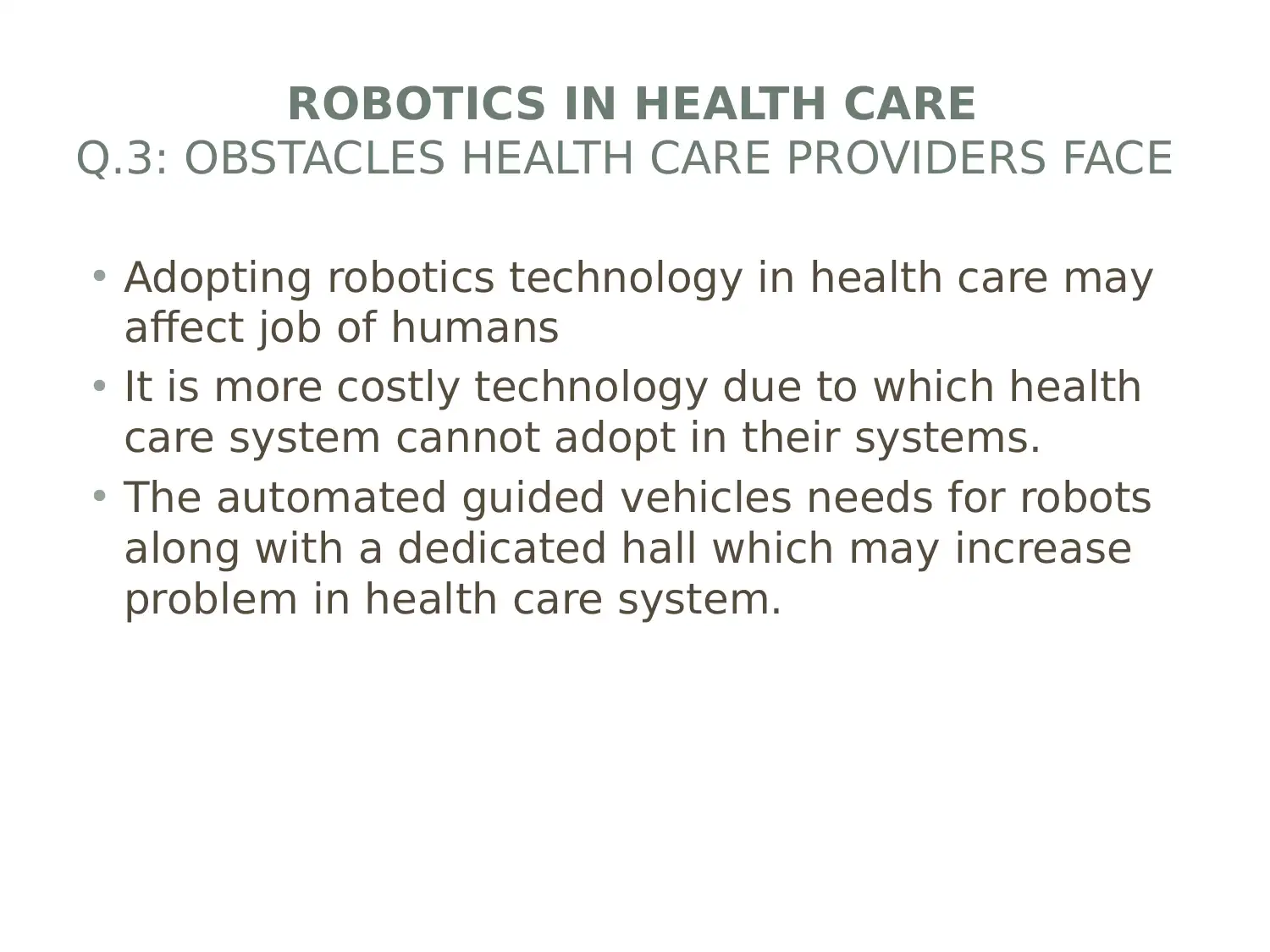
ROBOTICS IN HEALTH CARE
Q.3: OBSTACLES HEALTH CARE PROVIDERS FACE
• Adopting robotics technology in health care may
affect job of humans
• It is more costly technology due to which health
care system cannot adopt in their systems.
• The automated guided vehicles needs for robots
along with a dedicated hall which may increase
problem in health care system.
Q.3: OBSTACLES HEALTH CARE PROVIDERS FACE
• Adopting robotics technology in health care may
affect job of humans
• It is more costly technology due to which health
care system cannot adopt in their systems.
• The automated guided vehicles needs for robots
along with a dedicated hall which may increase
problem in health care system.
⊘ This is a preview!⊘
Do you want full access?
Subscribe today to unlock all pages.

Trusted by 1+ million students worldwide
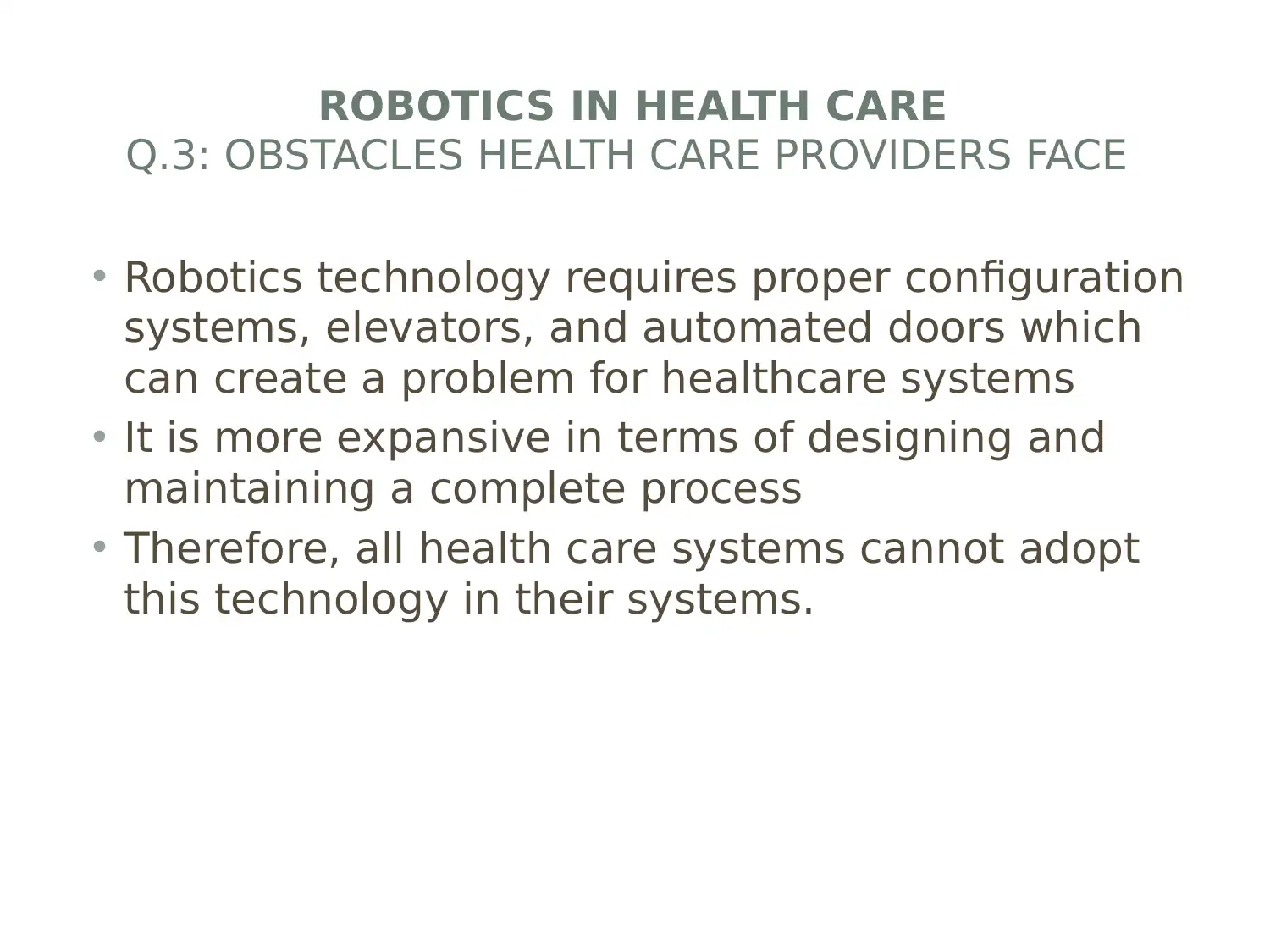
ROBOTICS IN HEALTH CARE
Q.3: OBSTACLES HEALTH CARE PROVIDERS FACE
• Robotics technology requires proper configuration
systems, elevators, and automated doors which
can create a problem for healthcare systems
• It is more expansive in terms of designing and
maintaining a complete process
• Therefore, all health care systems cannot adopt
this technology in their systems.
Q.3: OBSTACLES HEALTH CARE PROVIDERS FACE
• Robotics technology requires proper configuration
systems, elevators, and automated doors which
can create a problem for healthcare systems
• It is more expansive in terms of designing and
maintaining a complete process
• Therefore, all health care systems cannot adopt
this technology in their systems.
Paraphrase This Document
Need a fresh take? Get an instant paraphrase of this document with our AI Paraphraser
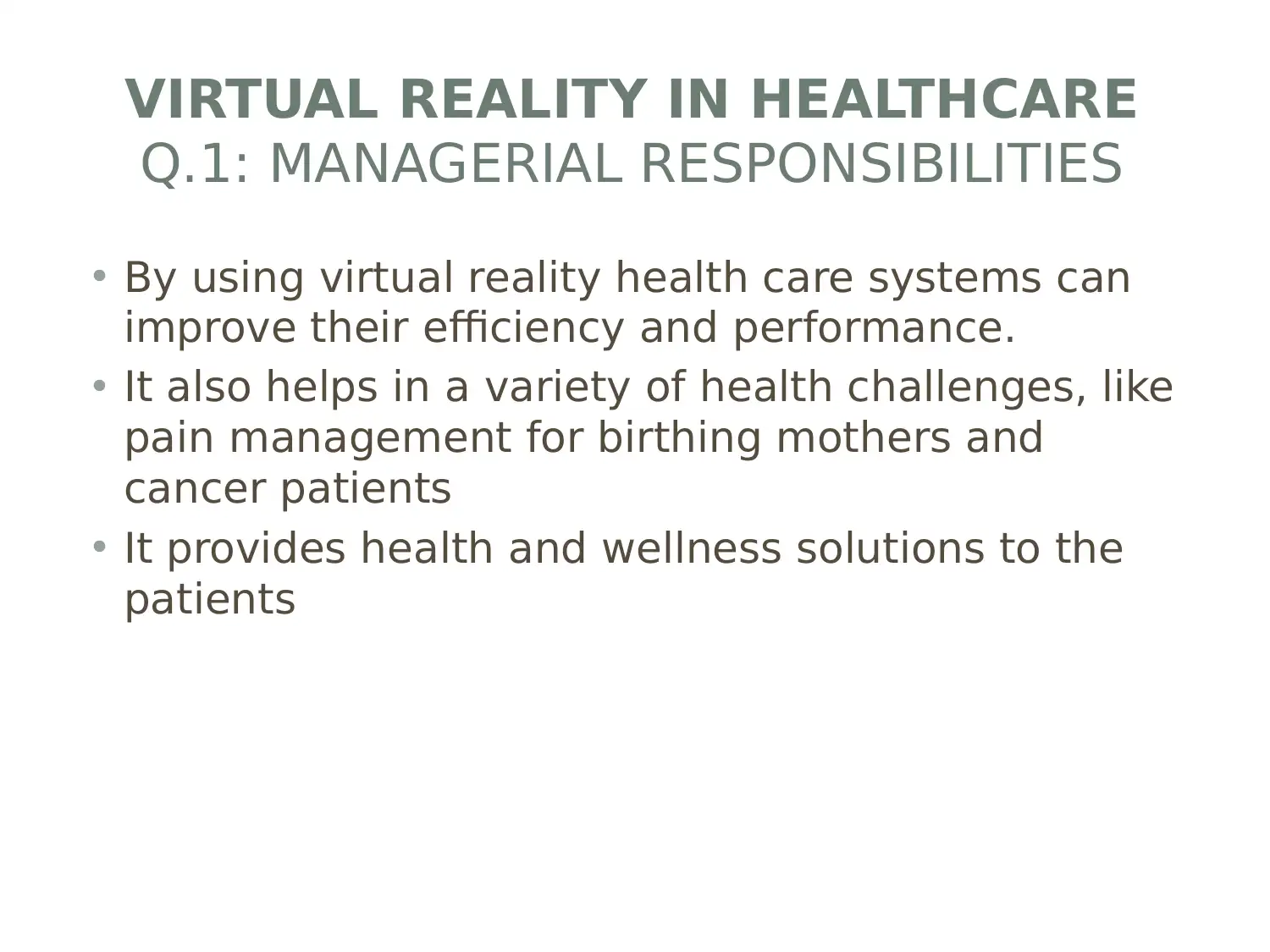
VIRTUAL REALITY IN HEALTHCARE
Q.1: MANAGERIAL RESPONSIBILITIES
• By using virtual reality health care systems can
improve their efficiency and performance.
• It also helps in a variety of health challenges, like
pain management for birthing mothers and
cancer patients
• It provides health and wellness solutions to the
patients
Q.1: MANAGERIAL RESPONSIBILITIES
• By using virtual reality health care systems can
improve their efficiency and performance.
• It also helps in a variety of health challenges, like
pain management for birthing mothers and
cancer patients
• It provides health and wellness solutions to the
patients
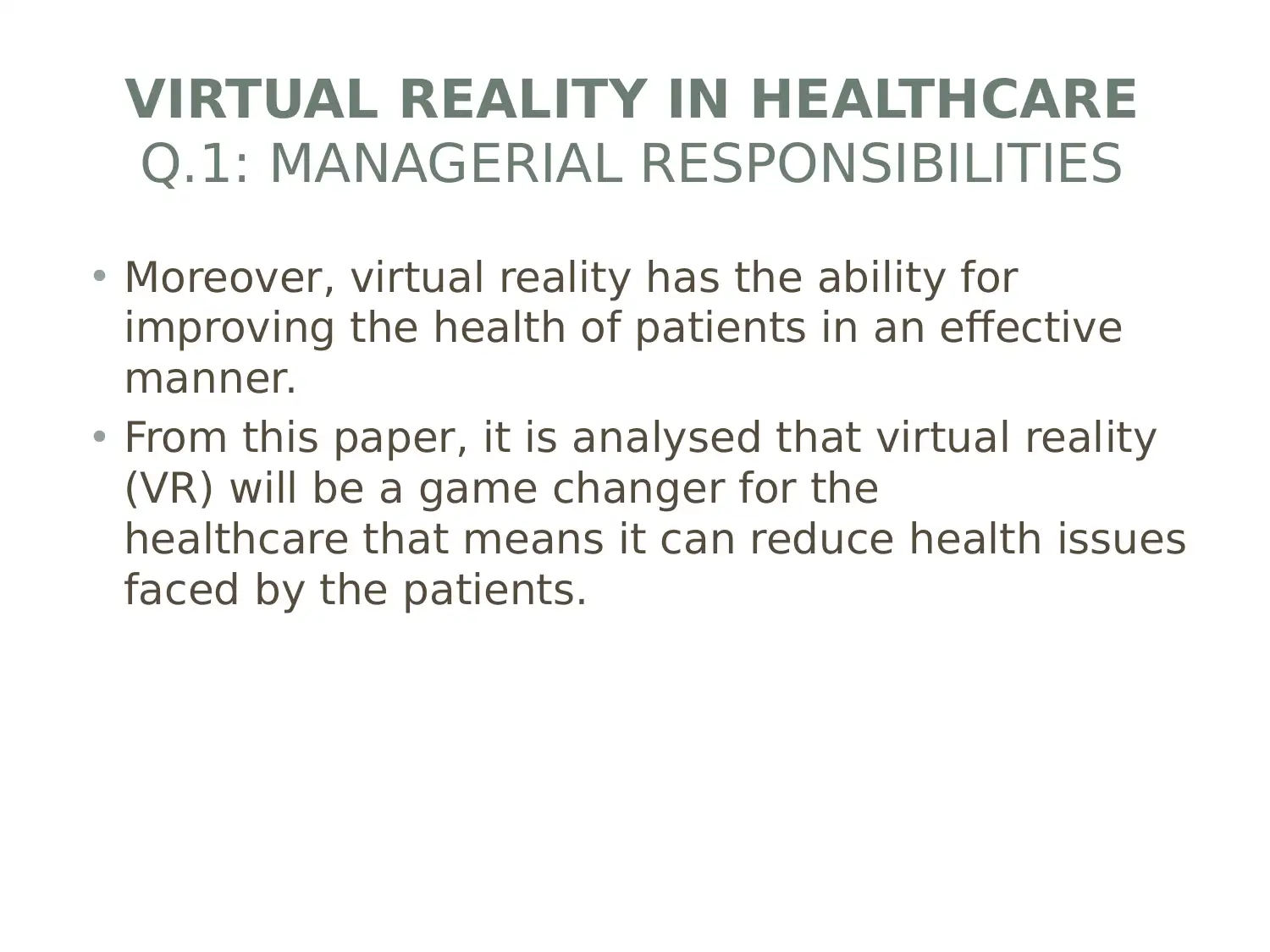
VIRTUAL REALITY IN HEALTHCARE
Q.1: MANAGERIAL RESPONSIBILITIES
• Moreover, virtual reality has the ability for
improving the health of patients in an effective
manner.
• From this paper, it is analysed that virtual reality
(VR) will be a game changer for the
healthcare that means it can reduce health issues
faced by the patients.
Q.1: MANAGERIAL RESPONSIBILITIES
• Moreover, virtual reality has the ability for
improving the health of patients in an effective
manner.
• From this paper, it is analysed that virtual reality
(VR) will be a game changer for the
healthcare that means it can reduce health issues
faced by the patients.
⊘ This is a preview!⊘
Do you want full access?
Subscribe today to unlock all pages.

Trusted by 1+ million students worldwide
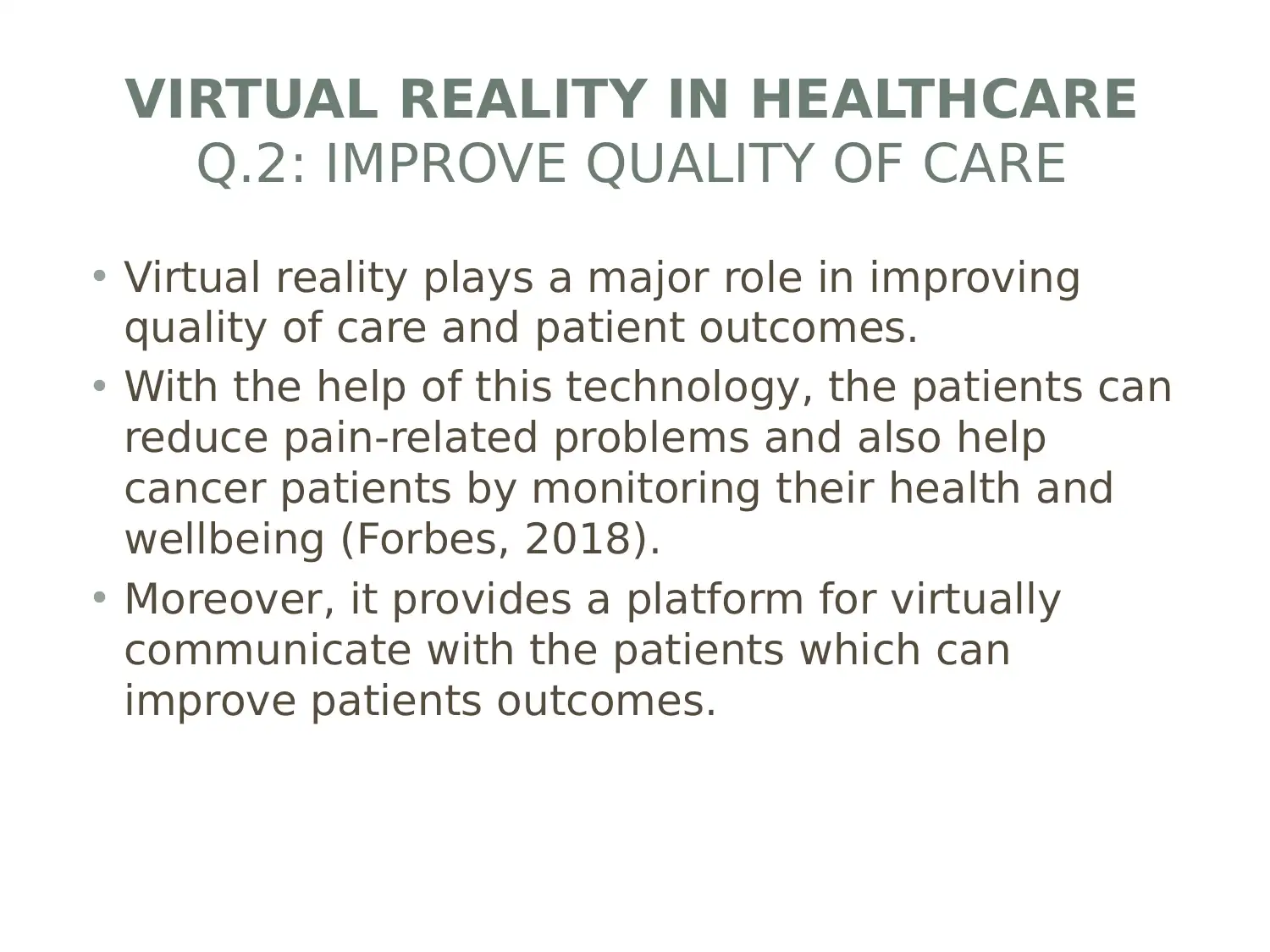
VIRTUAL REALITY IN HEALTHCARE
Q.2: IMPROVE QUALITY OF CARE
• Virtual reality plays a major role in improving
quality of care and patient outcomes.
• With the help of this technology, the patients can
reduce pain-related problems and also help
cancer patients by monitoring their health and
wellbeing (Forbes, 2018).
• Moreover, it provides a platform for virtually
communicate with the patients which can
improve patients outcomes.
Q.2: IMPROVE QUALITY OF CARE
• Virtual reality plays a major role in improving
quality of care and patient outcomes.
• With the help of this technology, the patients can
reduce pain-related problems and also help
cancer patients by monitoring their health and
wellbeing (Forbes, 2018).
• Moreover, it provides a platform for virtually
communicate with the patients which can
improve patients outcomes.
Paraphrase This Document
Need a fresh take? Get an instant paraphrase of this document with our AI Paraphraser
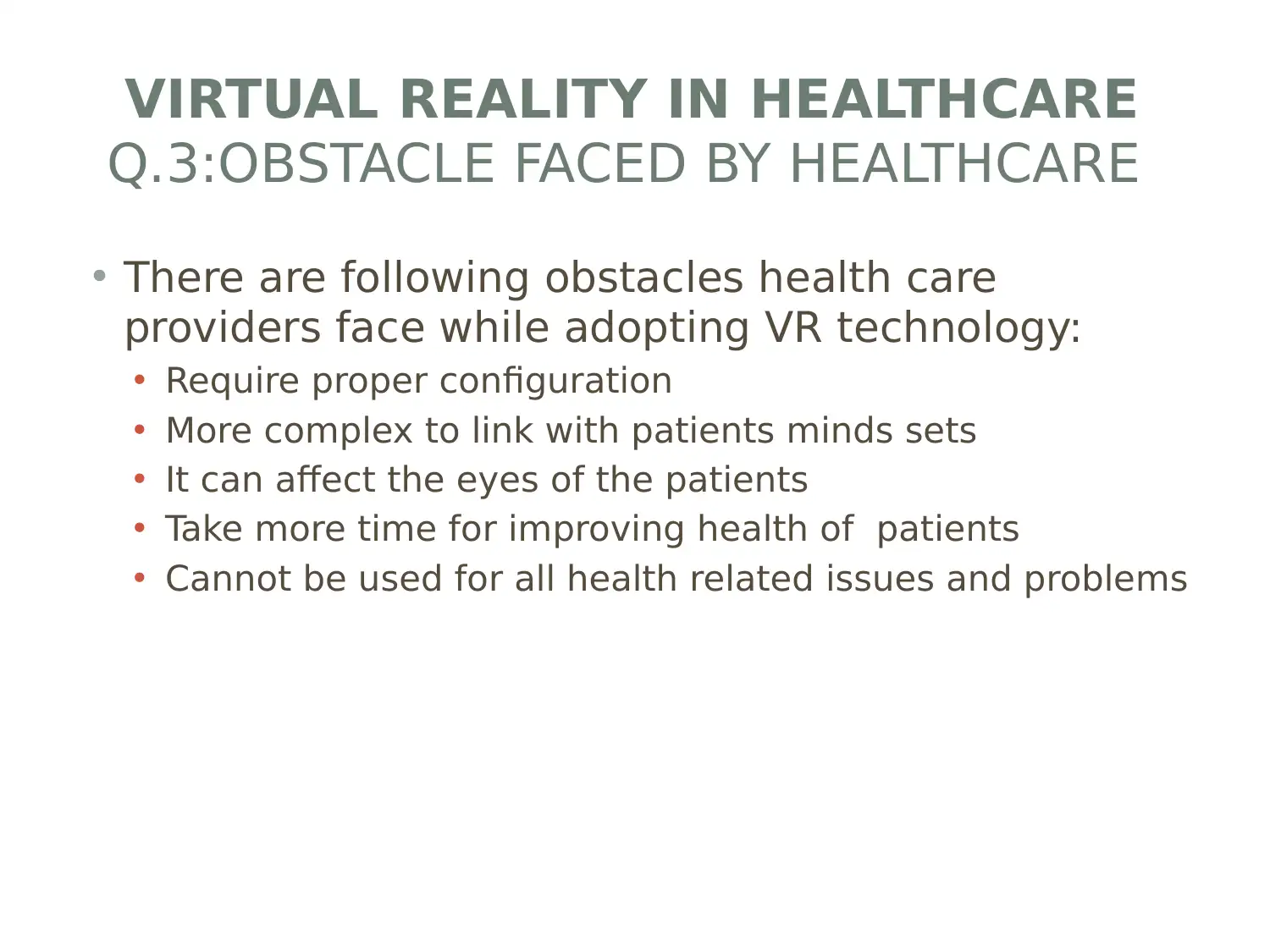
VIRTUAL REALITY IN HEALTHCARE
Q.3:OBSTACLE FACED BY HEALTHCARE
• There are following obstacles health care
providers face while adopting VR technology:
• Require proper configuration
• More complex to link with patients minds sets
• It can affect the eyes of the patients
• Take more time for improving health of patients
• Cannot be used for all health related issues and problems
Q.3:OBSTACLE FACED BY HEALTHCARE
• There are following obstacles health care
providers face while adopting VR technology:
• Require proper configuration
• More complex to link with patients minds sets
• It can affect the eyes of the patients
• Take more time for improving health of patients
• Cannot be used for all health related issues and problems
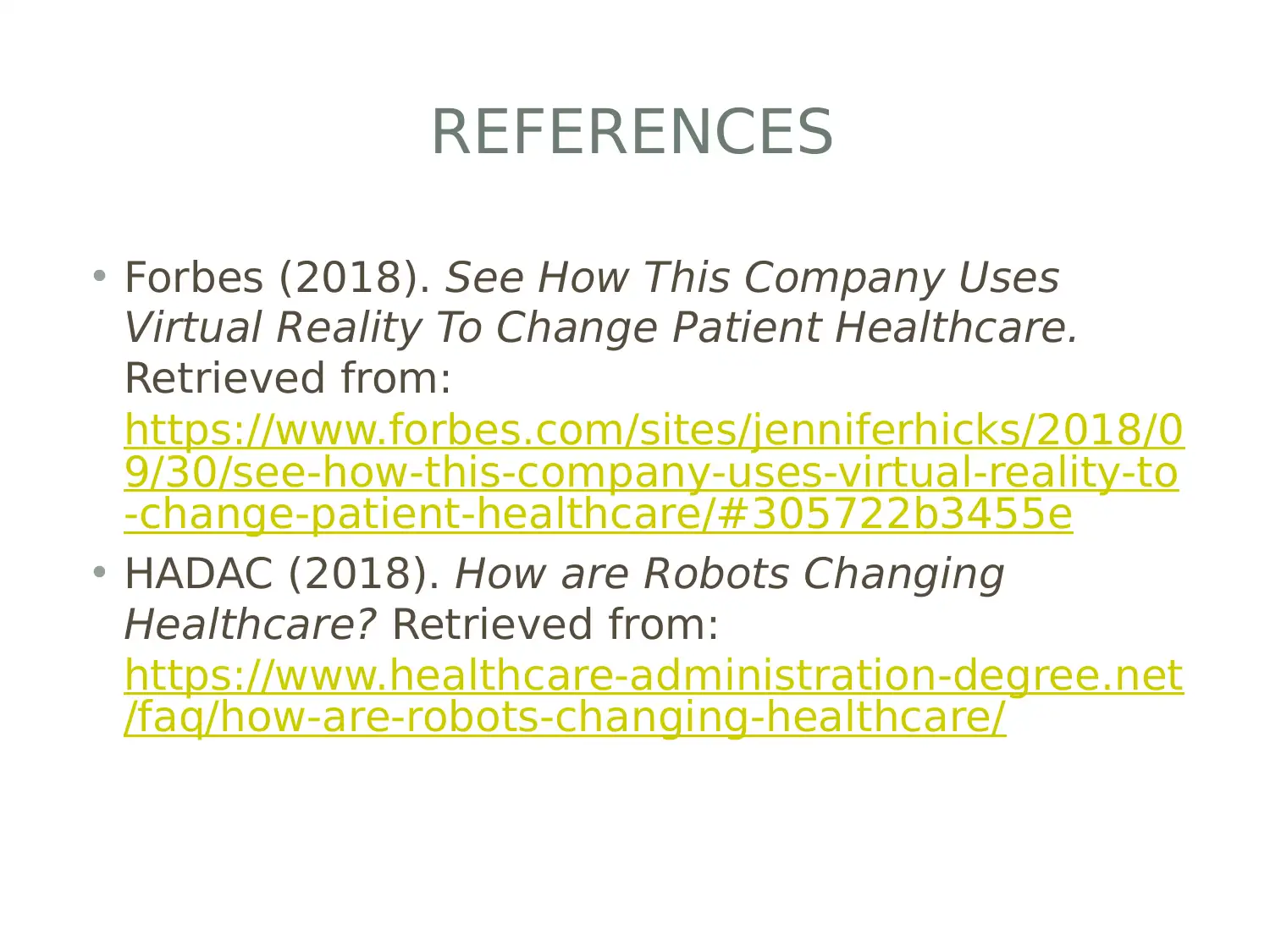
REFERENCES
• Forbes (2018). See How This Company Uses
Virtual Reality To Change Patient Healthcare.
Retrieved from:
https://www.forbes.com/sites/jenniferhicks/2018/0
9/30/see-how-this-company-uses-virtual-reality-to
-change-patient-healthcare/#305722b3455e
• HADAC (2018). How are Robots Changing
Healthcare? Retrieved from:
https://www.healthcare-administration-degree.net
/faq/how-are-robots-changing-healthcare/
• Forbes (2018). See How This Company Uses
Virtual Reality To Change Patient Healthcare.
Retrieved from:
https://www.forbes.com/sites/jenniferhicks/2018/0
9/30/see-how-this-company-uses-virtual-reality-to
-change-patient-healthcare/#305722b3455e
• HADAC (2018). How are Robots Changing
Healthcare? Retrieved from:
https://www.healthcare-administration-degree.net
/faq/how-are-robots-changing-healthcare/
⊘ This is a preview!⊘
Do you want full access?
Subscribe today to unlock all pages.

Trusted by 1+ million students worldwide
1 out of 12
Related Documents
Your All-in-One AI-Powered Toolkit for Academic Success.
+13062052269
info@desklib.com
Available 24*7 on WhatsApp / Email
![[object Object]](/_next/static/media/star-bottom.7253800d.svg)
Unlock your academic potential
Copyright © 2020–2025 A2Z Services. All Rights Reserved. Developed and managed by ZUCOL.





